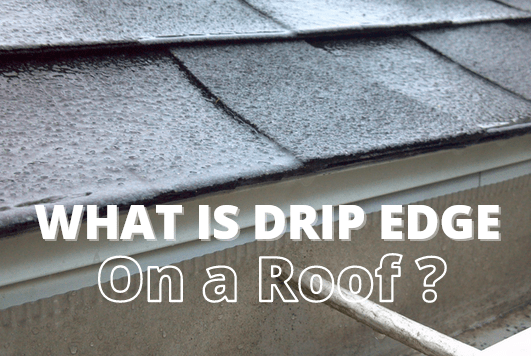A drip edge, often overshadowed by more prominent roofing elements, is essential in safeguarding your home. It’s a protective barrier that directs water away from vulnerable areas, minimizing the risk of damage and enhancing the roof’s longevity.
By effectively managing water runoff, the drip edge prevents water from seeping into the roof structure, which could lead to costly repairs. This seemingly small detail plays a significant role in maintaining a dry, well-protected home, providing peace of mind and ensuring the long-term durability of your roof.
What is a Drip Edge on a Roof?
A roof drip edge is a drip edge flashing, a piece of metal flashing that is securely installed along the perimeters of a roof. It performs two primary functions, crucial in preventing water damage and enhancing the roof’s structural integrity.:

To further understand the importance of a drip edge, it’s worth noting that roofing contractors recommend the use of specific drip edge materials tailored to local weather conditions. These materials are designed to withstand environmental stressors such as wind-driven rain and temperature fluctuations, ensuring that they function effectively under various climatic conditions.
This customization helps extend the lifespan of both the shingles or other roofing materials and the entire roofing system.
● Water Diversion
The drip edge directs runoff water from the roof away from the fascia—the board that connects the roof to the house’s outer walls. This practical water management prevents water accumulation under the roofing materials and guards against potential water damage.
● Pest Control
Besides water management, a drip edge is a physical barrier that deters tiny pests like rodents and insects from infiltrating the small spaces between the roofing materials and the home’s structural framework.
Types of Drip Edges
There are three main types of drip edges, each designed to cater to specific roofing requirements and aesthetic preferences:
● Type C
This is a simple L-shaped edge that fits snugly against the roof deck. It is the most basic and commonly used type of drip edge.
● Type D
Also referred to as “D-style,” this type has a protruding outer edge that provides a decorative look. It is typically used for shingle roofs.
● Type F
Known as “F-style” or “gutter apron,” this type has a longer edge that extends into the gutter. This design provides optimal water diversion, ensuring water flows away from the fascia and into the gutter.
Read also: Is a Drip Edge Necessary on a Roof?
Understanding Drip Edge Requirements in Building Codes
Building codes are rules and standards established by governing bodies to ensure the structural safety, health, and general welfare of the inhabitants of buildings. These codes vary greatly depending on geographic location, climatic conditions, and local regulations.
Regarding roofing, the International Residential Code (IRC) has recognized the importance of drip edges and included their installation in its roofing requirements. The IRC mandates that drip edges should be installed on shingles and asphalt roofs, and it specifies how they should be installed for maximum efficiency.
However, not all local codes have adopted these stipulations, and in some regions, drip edge installation might not be a mandatory requirement. This disparity underscores the importance of consulting with local building inspectors or professional roofers who are well-versed in the local building codes.
Why Skipping a Drip Edge Can Lead to Roofing Problems?
Omitting a proper drip edge roof installation can lead to several problems, including:
● Water Damage
Without a proper drip edge, water can seep under the shingles or other roofing materials, leading to rot in the roof deck, fascia, soffit, or even the interior of your home. This could result in expensive repairs or even a premature roof replacement, emphasizing the crucial role of the drip edge in preventing water damage.
● Pest Infestations
A missing drip edge creates an inviting gap for pests to enter. Rodents and insects can enter these gaps, causing potential damage and health hazards.
● Structural Deterioration
Over time, the absence of a drip edge can result in the delamination of the roof deck and the deterioration of the fascia board, undermining the overall structural integrity of your home.
Drip edge on a roof is a critical component of a well-structured roof. Its dual role in diverting water and deterring pests makes it an integral part of any successful roofing system.


